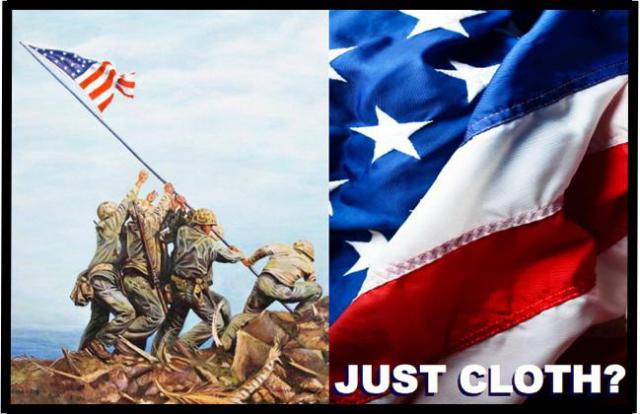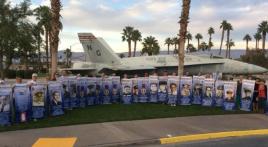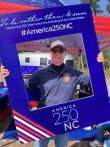Once at an event where our American flag was presented and given its due respect and honors, I overheard someone in the crowd softly say to the person next to them; “ I love my country, but the flag is just cloth.”
“Just cloth.”
I realize some people have trouble with symbolism, and may not see what is behind it, but anyone that could say such a thing so casually about the American flag makes me question if they truly do know what it means to love their country. In our free country that individual can believe what they want, and as much as I wanted to tell this person a thing or two, I knew it would be a waste of my time, and only get me into an argument. So I will say it here.
Our flag was not just cloth when after five years of brutal fighting, on October 19, 1781, General Charles Cornwallis surrendered to American forces at Yorktown Virginia. A rag tag Continental Army with little training and not half the massive weaponry, took on and beat handsomely the best trained, most highly disciplined and well supported fighting force in the world. The Army and Navy of Great Britain.
On September 13, 1814, 30 British ships after entering the Chesapeake Bay, proceeded to Baltimore Harbor and prepared to attack Fort McHenry. On board a British ship about eight miles from the fort, Francis Scott Key negotiated the release of a friend who had been taken prisoner by the British. Both Key and his friend were kept detained on the ship during the massive assault on the American fortress. The fortress was pounded by British bombs and rockets for 25 hours. Reports from that time say an estimated 1800 bombs and rockets were lobbed onto the fort. After an entire night of brutal shelling, the British navy ran out of ammunition, and Fort McHenry held strong. On the morning of September 14, 1814, the Commander of the fort, Major General George Armistead struck the torn beaten colors of the American flag that took so much fire and shelling, and ran up the pole a huge American flag (30 x42 feet) specially sewn by Mary Pickersgill in anticipation of the attack. Key was so inspired that morning seeing the American flag still waving proudly, he penned a poem “Defense of Fort McHenry” which later was set to music and became the “Star Spangled Banner” our national anthem. I doubt Francis Scott Key thought it was just cloth.
Nor was it just cloth when General Andrew Jackson successfully fortified and defended the town of New Orleans against a much larger attacking British force. In a matter of a few weeks he correctly determined the point of the British attack, put together a rowdy crew of misfits, small militias, and even a navy of pirates, created barriers, water filled moats, and crude fortifications and set up a strategy that totally outfoxed the British forces. When the cannon smoke cleared, hundreds of British dead lay like a bloody carpet in swampy fields. Jackson became the hero who saved New Orleans, and it was the last major battle of the war.
Ask Union soldiers standing at attention after the battle of Appromattox Courthouse in Virginia if the Union flag, symbol of the Union they fought so hard to preserve was just cloth. The Confederate soldiers had stacked their arms, and also stood at attention as their leader, General Robert E. Lee sat inside the home of Wilmer McLean with General Ulysses S. Grant commander of all Union forces, and reviewed the terms of surrender. After four horrible years of fighting and suffering, and losses on both sides in numbers never seen or imagined before in this country, on April 9th 1865, General Robert E. Lee signed the terms of surrender ending the days of brother killing brother, and Americans killing their fellow Americans. Just five days later President Abraham Lincoln would be shot in a theater by John Wilkes Booth. Not even a week after a terrible civil war has ended, the American flag was draped over the coffin of a dead U.S. President.
It was not just cloth when on the morning of February 21 1945 Navy Hospital corpsman John “Doc” Bradley, a member of a Marine Corps combat patrol, scrambled and fought their way to the top of Mount Suribachi. After two hours of fighting the Japanese to get to the mountain top, at about 10:20 a.m. Bradley and others in his unit raised an American flag they purposely took up with them, signaling the taking by American forces of the highest point on the island of Iwo Jima. The battle was far from over, but cheers from thousands of men on the beaches and out on ships could be heard from the mountain top, and it inspired the American units to press on. Later using a bigger flag and better pole rigging, another flag was raised in a re-enactment of raising the original. Ironically corpsman John Bradley was not part of the group in the iconic Iwo Jima photograph by Joe Rosenthal.
I would like to add a personal note.
On a cool early May morning 1975, I was standing at attention in dress whites, looking out from the watch’s platform on the starboard side just outside the bridge of the destroyer U.S.S Bigelow. We were ceremoniously “manning the rails,” the traditional rendering of honors used by all naval vessels. All men not on duty, that is men not assigned to control the ship for departure, stands in dress uniform evenly spaced along the rails the length of the ship. Manning the rails is only done when departing for home port and arriving at home port after a long departure. (Also when leaving home port for a long cruise) I’m sure it was quite an impressive sight to the crowd of Norwegians on the dock seeing us off. On this day we were about to head back to the United States after a 6 month Med - Europe cruise. It will take us 18 days.
Our ship was in a very narrow fjord in the colorful small town of Kristiansund, on the southern tip of Norway. Steep rocky bluffs, bathed in the suns first rays, stood tall not far before us. I heard the low rumble of the engines starting, and soon our ship was starting to rotate away from the dock in a 180 degree rotation to head out to sea. Suddenly and very unexpectedly, John Denver’s “Take Me Home, Country Roads” blasted out of the ship’s PA system over the water. It echoed eerily off the rock walls of the mountains in an incredible amplification of natural acoustics that gave me chills. It’s message made my heart pound, as I let the suppressed pangs of homesickness finally be recognized. It had been a long time. A better song for that moment could not have been chosen. As Denver’s music faded, we were dismissed to quarters. I saw men in my division wiping tears from their cheeks. I too was moved to tears, and I’d bet there was not a dry eye on the ship. I remember looking up at a rich blue sky, and seeing thin wisps of clouds painted orange from the rising sun. And there high on a pole over the bridge, I saw old glory waving proudly. We were heading home. And that beautiful flag I saw, was not just cloth.

Just cloth
Kingston, NY
April 13, 2018
Submitted by:
Glenn H. Chapman



